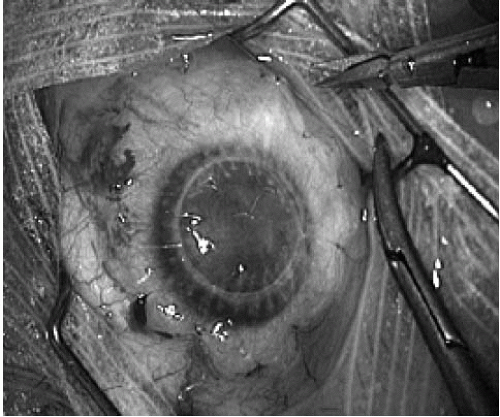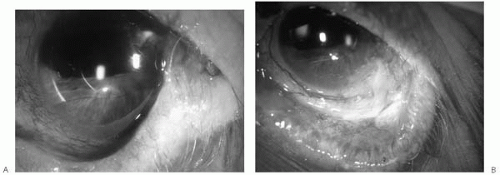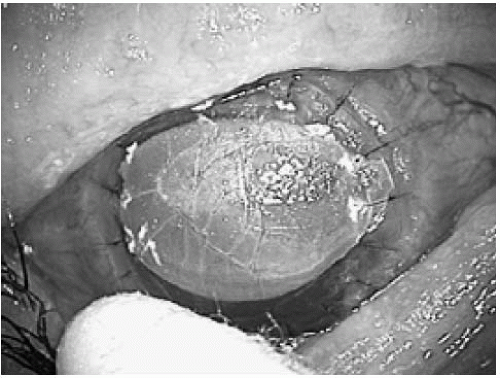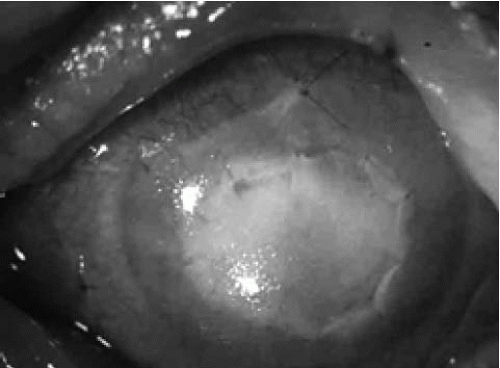Amniotic membrane transplantation (AMT) is indicated for numerous ocular surface disorders, the spectrum of which has been expanding recently (
Table 58-1). The first written report on the use of amniotic membrane graft (AMG) in clinical medicine was made after Davis used both chorion and amnion in skin transplantation cases in 1910 (
1). Since then, living (rather than preserved) amniotic membrane has been used for various purposes (
2). The first report on the use of amniotic membrane for ocular disorders was by DeRoth in 1940; he used both amnion and chorion in the treatment of conjunctival defects (
3). After a half century of lack of written reports on amnion use for ocular surface disorders, Battle and Perdomo introduced, in 1993, the idea of amniotic membrane transplantation to North America (
4). Two years later, Kim and Tseng published their observations that preserved amniotic membrane facilitated corneal surface healing in rabbits after epithelial removal and limbal lamellar keratectomy (
5). Since then, the use of amniotic membrane has been explored in a growing number of ocular surface disorders.
BASIC SCIENCE
Human amnion is the innermost layer of the placenta. It is composed of five layers that can be distinguished histologically (
6). These include a single epithelial layer, a basement membrane, and an avascular connective tissue that is composed of three layers: the compact layer attached to the basement membrane, the fibroblast layer, and the spongy layer (
6). The thickness of human amnion is approximately 0.02 to 0.50 mm (
6). The epithelium consists of one layer of cells, the shape of which varies between cuboidal in the amnion reflectum, to columnar over the placental surface, and squamous over the cord amnion (
7). The basement membrane consists of reticular fibers with processes to the basal region of the epithelial cells (
6). The compact layer is thought to be the strongest layer, with significant tensile strength (
6). The fibroblast layer is the thickest layer of the amnion and contains a loose fibroblast network and reticulum (
6). The spongy layer is the outermost layer of the amnion. It contains wavy bundles of reticulin and scattered fibroblasts (
6).
The mechanisms by which amniotic membrane promotes healing of the ocular surface are not fully understood. The previously proposed mechanism of action through oxygen permeability, epithelial hydration, and mechanical protection (
8) may be too simplistic because soft contact lenses have these characteristics, too (
9), yet there are numerous reports on cases where AMT resulted in epithelialization of epithelial defects after bandage soft contact lens therapy failed. There is growing evidence that biologic factors, including collagens and cytokines, may make a major difference between a soft contact lens and amniotic membrane. The amniotic membrane is believed to provide a superior substrate for migration of epithelial cells (
10), reinforce adhesion of basal epithelial cells (
11,
12), promote epithelial differentiation (
13,
14,
15,
16), prevent apoptosis of epithelial cells (
17,
18), and reduce neovascularization and fibrosis by reduction of inflammatory cell infiltration (
19,
20,
21).
Both collagens IV and VII, components of corneal and conjunctival epithelial basement membrane, are present in the basement membrane of amniotic membrane (
22). In addition, amniotic membrane contains collagen III (another collagen component of conjunctival epithelial basement membrane), collagens I, II, and V, fibronectin, and laminin (
22,
23,
24,
25). The composition of amniotic basement membrane may be closer to conjunctival than to corneal basement membrane based on the presence of type IV collagen and laminin subchains (
22).
The presence of cytokines expressed in the amniotic membrane has been investigated recently. The experiments show that cytokines that promote epithelialization and reduce inflammation, scarring, and neovascularization are present in preserved (
26) as well as epithelium-denuded amniotic membrane (
27). These cytokines are found in both the epithelium and stroma of the amniotic membrane, but are believed to be synthesized predominantly by the epithelium (
28). The cytokines are present in cryopreserved amniotic membrane (
26) and, surprisingly, approximately 50% of the epithelial cells of amniotic membrane
cryopreserved for several months can still be viable (
29). Hence, it is possible that the amnion epithelial cells continue production of cytokines after transplantation. Nerve growth factor, epidermal growth factor, keratocyte growth factor, and hepatocyte growth factor, all present in the amnion, may play a role in promoting the epithelialization of the ocular surface after AMT (
27,
28).
The mechanisms by which amniotic membrane may reduce scarring, inflammation, and angiogenesis are more complex. Amniotic membrane matrix uniquely suppresses transforming growth factor-
β signaling, resulting in reduction in fibroblasts and scarring (
30). The AMGs trap inflammatory cells of monocyte-macrophage lineage that show signs of apoptosis (
31). Fresh human amniotic epithelial and mesenchymal cells express potent antiangiogenic agents, interleukin-1 receptor antagonist, all four matrix metalloproteinase inhibitors, collagen XVIII, interleukin-10, and thrombospondin-1 (
26). Similar observations were made in residual epithelial cells and stroma of cryopreserved amniotic membranes (
26).
Unlike other allograft transplantations, AMT does not require administration of systemic immunosuppressive therapy to prevent immune rejection. The amniotic membrane typically dissolves within 3 to 5 weeks. It is not clear whether alloreactive immune mechanisms are involved in the process of amniotic graft dissolution after placement onto the ocular surface. The earlier hypotheses about lack of immune rejection response proposed that this phenomenon is a result of lack of human leukocyte antigens (HLA) in a cryopreserved amniotic membrane, but recent studies suggest that the issue is more complex. It is believed that amnion is an immune-privileged tissue (
29). The epithelium, stroma, and fibroblasts of cryopreserved amniotic membrane contain HLA class I and II antigens, but the
amnion does have the ability to suppress alloreactive T cells
in vitro (
32). Furthermore, amnion expresses HLA-G, a nonclassic major histocompatibility complex class I molecule expressed in the extravillous cytotrophoblast at the fetomaternal interface, that protects the fetus from maternal cellular immunity. This antigen, along with some other immunoregulatory molecules (e.g., Fas ligand), plays a role in suppressing the infiltration of CD4+ and CD8+ T cells into amnion (
29).
PREPARATION AND STORAGE OF AMNION
The vast majority of clinical experience comes from the use of cryopreserved AMGs, but the use of fresh amniotic membrane has been previously reported (
33,
34,
35,
36). Both
in vivo and
in vitro studies suggest that there is very little or no difference between fresh and cryopreserved amniotic membranes. The amniotic membrane shows little morphologic change after cryopreservation in 50% glycerol (
37). Fresh amnion may be a good source of AMGs in countries where preserved tissue is not accessible, but the risk of blood-borne infections seems to be elevated (
33,
34). The cryopreserved amniotic membrane is typically stored in −80°C on a nitrocellulose paper in 50% glycerol with the epithelium side up. The epithelium side is smooth and can be distinguished from the sticky stromal side by touching it with a Weck-cel sponge (Edward Weck & Co, Inc., Research Triangle Park, NC). The AMGs can be stained before removal from the nitrocellulose paper with lissamine green B 1% that is not toxic to corneal epithelium and allows for better visualization of edges and folds or wrinkles during the surgical procedure. The color of the amniotic membrane returns to normal within 120 minutes of application of the dye.
The preparation and preservation techniques for AMGs were first described by Lee and Tseng (
38). Amnion is obtained from placentas of donors undergoing elective caesarean section to eliminate contamination from vaginal delivery (
39). Donor screening to exclude the presence of human immunodeficiency virus (HIV)-1 and HIV-2 (HIV-1 and HIV-2 antibodies), hepatitis B (surface antigen and core antibody), hepatitis C (antibody), human T-lymphocyte virus 1 and 2 (antibodies), and syphilis (rapid plasma reagin) in the donor’s serum are performed before harvesting placenta, and this is repeated 6 months later to guard against transmission of blood-borne pathogens. The placenta is transported under sterile conditions to a lamellar-flow hood and cleaned of blood clots with sterile Earle’s balanced saline solution (Life Technologies, Inc., Gaithersburg, MD) containing 50
μg/mL of penicillin, 50
μg/mL of streptomycin, 100
μg/mL of neomycin, and 2.5
μg/mL of amphotericin (Bio-Tissue Form #H-005.0, Miami, FL). The amnion is separated from chorion by blunt dissection and placed onto nitrocellulose paper with a pore size of 0.45
μm (Bio-Rad, Gainesville, FL) with the epithelium side up. The nitrocellulose paper with amnion is then cut into pieces typically not larger than 4 cm × 4 cm and stored at −80°C in a sterile vial containing Dulbecco’s modified Eagle medium (Life Technologies, Inc.) and glycerol (Baxter Healthcare Corporation, Stone Mountain, GA) at the ratio of 1:1.
Preserved human AMGs can be prepared as previously described, provided the availability of trained personnel, access to the ingredients, equipment necessary for processing the tissue, and storage equipment exist. Preserved amnion is also commercially available, either cryopreserved (Bio-Tissue, Miami, FL) or low-heat-dehydrated and sterilized (OKTO Ophtho, Costa Mesa, CA). Unlike low-heat-dehydrated amnion, cryopreserved amnion requires storage at −80°C if stored longer than 4 weeks. It can be stored at −20°C for as long as 4 weeks before use (Bio-Tissue, AmnioGraft Information Summary). The cryopreserved amnion is thawed before its use in the operating room. The low-heat-dehydrated amnion is stored at room temperature and is rehydrated with saline solution minutes before use. Unlike cryopreserved amnion, low-heat-dehydrated amnion is supplied without a carrier sheet.







